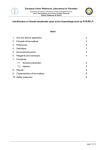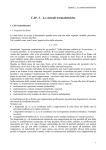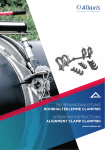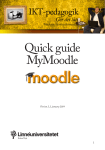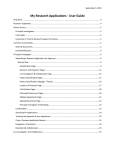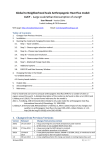Download User guide – ISP (Individual study plans for doctoral students)
Transcript
User guide – ISP (Individual study plans for doctoral students) January 2015 This is a translated version of the Swedish original. In case of differences between the Swedish version and the English translation, the Swedish original shall prevail. 1. Introduction..................................................................................................................................... 3 1.1 What is an individual study plan (ISP)? ..................................................................................... 3 1.2 Rules regarding ISPs and third-cycle studies ............................................................................. 3 2. Authorisation and system login....................................................................................................... 3 2.1 Authorisation ............................................................................................................................. 3 2.2 Logging into the system............................................................................................................. 4 2.3 ISP system help and support ..................................................................................................... 4 2.4 Roles in the system .................................................................................................................... 4 3. Create–Approve–Finalize the study plan ........................................................................................ 5 3.1 Normal process (all faculties except Sahlgrenska) .................................................................... 5 3.2 ISP process at Sahlgrenska ........................................................................................................ 6 4. Navigating and using the system ..................................................................................................... 8 4.1 As principal supervisor .............................................................................................................. 8 4.2 As assistant supervisor ............................................................................................................ 10 4.3 As doctoral student ................................................................................................................. 11 4.4 As student examiner and Head of Department ...................................................................... 11 5. The information in the ISP document ........................................................................................... 12 Important information about obtaining data from Ladok and Palasso!....................................... 13 5.1 Basic information..................................................................................................................... 13 5.2 About the programme ............................................................................................................. 14 5.3 Rate of study and Student finance .......................................................................................... 15 5.4 Courses and conferences ........................................................................................................ 16 1 5.5 Supervision and examination .................................................................................................. 17 5.6 The thesis................................................................................................................................. 19 5.7 Progress meetings ................................................................................................................... 20 5.8 Comments ............................................................................................................................... 20 5.9 Ethical approvals ..................................................................................................................... 20 5.10 Attachments .......................................................................................................................... 20 5.11 Message log ........................................................................................................................... 21 6. Revision of study plan ................................................................................................................... 21 7. Archiving of ISPs ............................................................................................................................ 21 8. Special cases .................................................................................................................................. 21 2 1. Introduction 1.1 What is an individual study plan (ISP)? An ISP must be established for each doctoral student. The study plan serves as a steering instrument for the entire length of the programme and shall ensure that the studies are conducted and followed up in an effective manner. The ISP is established and revised jointly by the doctoral student, supervisor and student examiner. It is approved and thereby finalised by the Head of Department. The Head of Department is to ensure that the ISP is reviewed and revised at least once a year. Revisions shall also be made as deemed necessary in relation to the progression of the studies as well as on request by the doctoral student. Some information in the document is obtained during the studies from the Ladok documentation system. As this data cannot be entered manually, you have to contact your Ladok administrator if any such information needs to be changed. An ISP is a public document and is therefore made available as such. Please remember this when entering information into the system. There are currently two versions of the University’s ISP process. All faculties except the Sahlgrenska Academy use the normal version; the Sahlgrenska Academy has adopted a separate process. 1.2 Rules regarding ISPs and third-cycle studies The rules concerning ISPs can be found in the Higher Education Ordinance and the University’s central rules and reglations for third-cycle studies. The different Faculties also have their own rules and guidelines for third-cycle studies. Links to Faculty-specific information can be found at http://doktorand.gu.se/english/. 2. Authorisation and system login 2.1 Authorisation Authorisation to access the ISP system, ‘roles’, are established by each Department’s ISP administrator in connection with the initial launching of the system. Please contact the ISP administrator if you should have access to the system but have not yet been authorised. The administrator assigns roles for both University staff and persons employed elsewhere, such as supervisors working at another university. Doctoral students are automatically granted access to the ISP system when their x-account is created. X-accounts are normally assigned automatically when admission to third-cycle studies is documented in Ladok. Assistant supervisors are authorised in the same way as principal supervisors. Assistant supervisors can log into the system but can only view the study plan as a non-editable PDF document. At the Sahlgrenska Academy, an ISP must be established prior to admission to third-cycle studies. Application for admission is made via the ISP system. An x-account must therefore be created 3 manually for doctoral applicants. X-accounts are created by the host Department’s authorisation administrator. 2.2 Logging into the system Doctoral students and University staff log into the system via the Staff Portal. Once logged in, ISPs can be accessed under ‘Tools’. After you have been authorised to access the ISP system, all you need to do is click the link ‘Open ISP’. Users who are not employed at the University must log in via a link at http://doktorand.gu.se/english/isp/. This also applies to persons who work at the University and who have an x-account, but who are employed elsewhere (for example at Chalmers or Sahlgrenska University Hospital). At the Sahlgrenska Academy, an ISP must be established for admission to third-cycle studies. Applicants to third-cycle studies at the Sahlgrenska Academy log into the system via a link at http://doktorand.gu.se/english/isp/. 2.3 ISP system help and support The user guide for the ISP system can be accessed via the ISP page at the Staff Portal (below the login field). You can also reach the manual in the system’s ‘Help’ menu. When completing the information in the actual ISP, you will find that most fields offer helpful information texts. 2.3.1 English version of the system To access the English version of ISP, simply select language at the top right after logging in. 2.4 Roles in the system Each system user has one of several available roles. The assigned role determines what a user can see and do in the system. The available roles are: Doctoral student – can revise created plan Supervisor – the principal supervisor creates the plan and makes revisions together with the doctoral student; the assistant supervisor can only access a PDF version of the plan Student examiner – can approve the study plan or return it for revision Faculty administrator (only at the Sahlgrenska Academy) – can approve the study plan or return it for revision Head of Department – can finalise the study plan or return it for revision A student examiner, faculty administrator (only at the Sahlgrenska Academy) and Head of Department cannot make changes in any of the fields, but can only approve an ISP/return it for revision and write in the message log. A key responsibility linked to the role of institution administrator (ISP administrator) is to assign other users their roles. The student examiner is selected in the study plan and then becomes tied to the ISP in question. If there is a need to change examiner, this must be done in connection with a revision. The role of Head of Department is linked to the department and cannot be changed in the study plan. 4 3. Create–Approve–Finalize the study plan The ISP process is characterised by a sequence of steps and involves users with different roles and authorisation levels. Before an ISP is finalised, it needs to pass a series of reviews. 3.1 Normal process (all faculties except Sahlgrenska) Before a study plan is established, the doctoral student must be admitted to third-cycle studies and the admission must have been documented in Ladok. The ISP administrator ensures that the principal supervisor is authorised to access the ISP system; that is, the administrator ensures that the principal supervisor has been assigned the role of supervisor. The institution administrator then informs the principal supervisor that the plan can be created. 3.1.1 The principal supervisor creates a study plan for the doctoral student The principal supervisor logs into the ISP system, clicks ‘Study plans’ –> ‘New study plan’ and then chooses doctoral student from the list (all doctoral students at the Department are displayed). Once a student has been selected, the form for the study plan is opened. Two buttons are displayed at the bottom of the form: ‘Create' and ‘Create & Close’. As soon as the supervisor has clicked ‘Create‘, the doctoral student can view the plan under ‘Study plans’ in the menu. As the doctoral student is not automatically notified that a study plan has been created, communication is necessary outside the ISP system. If the supervisor clicks ‘Create‘ (and not ‘Create & Close’), he/she can continue working on the plan and keep adding information. The buttons ‘Save’ and ‘Save & Close’ are now displayed at the bottom of the form. If ‘Save’ is clicked, the plan is saved and updated also for the student. 3.1.2 The doctoral student and principal supervisor add to the plan and approve it The doctoral student enters information into the document and can choose to save and close the plan with an intention to keep working on it later. When the student has finished the plan, he/she clicks ‘Approve and send’. This locks the plan for the student. A message that a study plan is available is sent to the supervisor. The supervisor can at this point add to the information inputted by the 5 student. If the supervisor makes changes, the document is automatically returned to the doctoral student for his/her approval. The plan will not be forwarded to the student examiner until the supervisor has approved the plan without revisions. 3.1.3 The student examiner approves the study plan Once the doctoral student and his/her supervisor have approved the plan, it is sent to the person selected as student examiner in the plan. The examiner is informed via email that he/she has an ISP to review and also receives a notification at the top of the ISP system start page. The examiner can view all document tabs but cannot make changes in any of the fields. He/she can leave a message in the message log, however. If the examiner does not approve the study plan, the document is returned to the principal supervisor. An email is then sent to the principal supervisor. Once the examiner has approved the plan, it is forwarded to the Head of Department. 3.1.4 The Head of Department finalises the study plan Once the student examiner has reviewed and approved the study plan, the Head of Department is informed that a study plan has been submitted for consideration. He/she is also notified via the start page of the ISP system. The Head of Department can view all document tabs but cannot make revisions. If he/she has concerns about the content, the document is returned to the examiner. 3.2 ISP process at Sahlgrenska At the Sahlgrenska Academy, the doctoral student has still not been admitted to third-cycle studies when the ISP is established. Doctoral applicants with a different employer are given access to the ISP system when a doctoral project has been established. For candidates applying in competition with others, access is given following selection by the supervisor. Before the ISP process is initiated, the applicant’s qualifications with respect to both general and specific entry requirements are reviewed by administrators at the Sahlgrenska Academy Office and the roles for all supervisors and the doctoral student are created by the institution administrator. 6 3.2.1 The principal supervisor creates the study plan for the doctoral student The principal supervisor logs into the ISP system and selects ‘Study plans’ in the menu. Next, he/she clicks ‘New study plan‘ and selects student from the list (all doctoral students at the Department are displayed). The ISP document opens as soon as a student has been selected. Two boxes are shown at the bottom of the form: ‘Create’ and ‘Create & Close'. As soon as the supervisor has clicked ‘Create‘, the doctoral student can view the plan under ‘Study plans’ in the menu. As the doctoral student is not automatically notified that a study plan has been created, communication is necessary outside the ISP system. If the supervisor selects ‘Create‘ (and not ‘Create & Close’), he/she can continue working on the plan and keep adding information. The buttons ‘Save’ and ‘Save & Close’ are now displayed at the bottom of the form. If ‘Save’ is clicked, the plan is saved and updated also for the student. At the Sahlgrenska Academy, the basic information about the student must be entered manually as he/she has not yet been formally admitted to a programme. The information can be entered by the principal supervisor or the doctoral applicant. 3.2.2 The doctoral student and principal supervisor add to the plan and approve it The doctoral student enters information into the document and can choose to save and close the plan with an intention to keep working on it later. When the student has finished the plan, he/she clicks ‘Approve and send’. This locks the plan for the student. A message that a study plan is available is sent to the supervisor. The supervisor can at this point add to the information inputted by the student. If the supervisor makes changes, the document is automatically returned to the doctoral 7 student for his/her approval. The plan will not be forwarded to the student examiner until the supervisor has approved the plan without revisions. 3.2.3 The student examiner approves the study plan Once the doctoral student and his/her supervisor have approved the plan, it is sent to the person selected as student examiner in the plan. The examiner is informed via email that he/she has an ISP to review and also receives a notification at the top of the ISP system start page. The examiner can view all document tabs, but cannot make changes in any of the fields. He/she can leave a message in the message log, however. If the examiner does not approve the study plan, the document is returned to the principal supervisor. An email is then sent to the principal supervisor. Once the examiner has approved the plan, it is forwarded to the Head of Department. 3.2.4 The faculty administrator reviews the ISP (only at the Sahlgrenska Academy) At the Sahlgrenska Academy, the student examiner sends the ISP to the faculty administrator, who in turn reviews it and then either approves it and forwards it to the Head of Department or returns it to the student examiner. The faculty administrator can also leave a comment in the message log (comments stay in the document throughout the process). The student examiner can in turn return the study plan to the student and principal supervisor for revision. The plan is then once again submitted to the student examiner, the faculty administrator and finally the Head of Department. 3.2.5 The Head of Department finalizes the study plan Once the student examiner and faculty administrator (only at the Sahlgrenska Academy) have reviewed and approved the study plan, the Head of Department is informed that a study plan has been submitted for consideration. He/she is also notified via the start page of the ISP system. The Head of Department can view all document tabs but cannot make revisions. If he/she has concerns about the content, the document is returned to the examiner. At the Sahlgrenska Academy, the study plan is returned to the faculty administrator. 4. Navigating and using the system The ISP system looks different depending on the role of the user. The menus and functions vary. If you have several roles, for example both principal supervisor and student examiner, you will always be logged in with the ‘higher’ authorisation level. So, if you are both a student examiner and a supervisor, you will be logged in as a student examiner. Click ‘Change permission’ in the menu to change role (authorisation level) if necessary. 4.1 As principal supervisor After logging into the ISP system you will see the following menu: 8 ISPs are created under ‘Study plans’. This tab also enables you to view all ISPs that you are involved in as principal or assistant supervisor. To create a study plan, click ‘New study plan‘ to the right. A list of the Department’s doctoral students will appear, and for the Sahlgrenska Academy the list will also include all doctoral applicants that have been included in the ISP system. You can do a name search if you are looking for a certain student. To create the plan, click ‘Choose’. The filter function enables you to search for study plans that you have been involved in as a supervisor. Type in the student’s full name (first name, family name) or do a search on part of the name and %. This will give you a list of all doctoral students with a name matching your search. You can also search on the subject. Select current study plans to view all created but non-finalised study plans as well as the most current versions of all finalised study plans. Look under archived study plans for finalised study plans for which there is a more current version. 9 Look under ‘Data’ for information about the doctoral students’ study time. ‘Employment period used’ shows the proportion of a 4-year doctoral studentship that has been completed (the calculation is based on a 48-month period of employment, as well as on full-time studies). ‘Used time (days)’ shows how many full-time days the doctoral student has completed. ‘Study period used (%)’ shows how much of the total period of study the student has completed. The proportion increases every time a completed activity is registered in Ladok. The calculation is based on a total third-cycle activity of 800% (corresponding to 4 years of full-time studies). 4.2 As assistant supervisor After logging into the ISP system, the following menu appears: Under ‘Study plans‘, you will find all ISPs that you are involved in as a principal or assistant supervisor. For information on how to search for a specific student or ISP, see Sec. 4.1. Note: As an assistant supervisor you can only view a non-editable PDF version of the created plan. 10 4.3 As doctoral student The start page of the ISP system shows two pie charts. Employment period used shows how much of the total 4-year employment period has been completed. The proportion/number of completed fulltime days is indicated below the chart. The second chart, LADOK, shows how much of the total period of study has been completed. The proportion increases every time a completed activity is registered in Ladok. The calculation is based on a total third-cycle activity of 800% (corresponding to 4 years of full-time studies). As new information about completed activity is obtained from Ladok, the remaining proportion of the original 800% is decreased. So, after one year of full-time studies, one-fourth of the chart will have been completed. Look under ‘Study plans‘ for your current study plan as well as previous versions. 4.4 As student examiner and Head of Department Under ‘Study plans’ you will find all ISPs that you are involved in. The filter function enables you to search for created study plans. Type in the student’s full name (first name, family name) or do a search on part of the name and %. This will give you a list of all doctoral students with a name matching your search. You can also search on the subject. Select current study plans to view all created but non-finalised study plans as well as the most current versions of all finalised study plans. Look under archived study plans for finalised study plans for which there is a more current version. 11 Look under ‘Data’ for information about the doctoral students’ study time. ‘Employment period used’ shows the proportion of a 4-year doctoral studentship that has been completed (the calculation is based on a 48-month period of employment, as well as full-time studies). ‘Used time (days)’ shows how many full-time days the doctoral student has completed. ‘Study period used (%)’ shows how much of the total period of study the student has completed. The proportion increases every time a completed activity is registered in Ladok. The calculation is based on a total third-cycle activity of 800% (corresponding to 4 years of full-time studies). 5. The information in the ISP document The information in several of the fields is obtained from other systems (mainly Ladok, but also Palasso). These fields are not editable and the text is grey. Not all information requested in the ISP system is completely necessary. However, in order to facilitate the ISP process, the information about the student examiner as well as title and description of the doctoral thesis is always required. For doctoral applicants at the Sahlgrenska Academy, the subject and Statistics Sweden code must be provided as well. 12 Important information about obtaining data from Ladok and Palasso! The button ‘Update data from Ladok and Palasso’ at the top of the form is used to obtain new data from Ladok and Palasso. New data from these systems will not be obtained unless the button is clicked! Make a practice of clicking the button every time you log into the plan. New data from Ladok and Palasso can be obtained until the supervisor approves the plan. If the obtained data seem to be incorrect, first verify the information in the source systems Ladok and Palasso, then contact the ISP systems administration. Remember to save your work frequently when working with the ISP. 5.1 Basic information Name Information obtained from Ladok/Palasso (primarily from Palasso if the student is registered there). Doctoral applicants at the Sahlgrenska Academy must enter first name and family name (only applicable when creating ISP version 1 prior to admission in Ladok). Civic registration number Information obtained from Ladok/Palasso (primarily from Palasso if the student is registered there). Doctoral applicants at the Sahlgrenska Academy must enter civic registration number (only applicable when creating ISP version 1 prior to admission in Ladok). Education fulfilling entry requirements If necessary (only at the Sahlgrenska Academy), indicate education that fulfils the entry requirements for the relevant doctoral programme (e.g. general entrance and special entrance requirements). Indicate degree, number of higher education credits and English B/TOEFL, as well as higher education institutions. Home address Indicate the home address of the doctoral student. Doctoral applicants at the Sahlgrenska Academy shall enter their home address (only applicable when creating ISP version 1 prior to admission in Ladok). Telephone number Indicate the telephone number of the doctoral student. Doctoral applicants at the Sahlgrenska Academy shall enter their telephone number (only applicable when creating ISP version 1 prior to admission in Ladok). E-mail address The student’s e-mail address is obtained from Palasso, but can be changed. 13 Subject Information obtained from Ladok. Sahlgrenska Academy: Choose research study subject and national subject (Statistics Sweden code) from the list. This applies only when creating ISP version 1, before admission in Ladok. Change of subject in active ISP process is not supported. The subject selected when creating an ISP cannot be changed. If a change is necessary, a new ISP must be created (note: not revised). Faculty Information obtained from Ladok/Palasso. Department Information obtained from Ladok/Palasso. Sahlgrenska Academy: Enter institute. Section, unit or equivalent The specific unit, section etc. (if any) that the doctoral student belongs to. Participating departments and/or divisions Indicate any participating departments and other units where part of the studies will be conducted. This applies only if the doctoral student’s research project is a coordinated project. Other participating institutes of higher education and organisations Indicate other participating institutes of higher education and organisations. This applies in particular to doctoral students in coordinated programmes and doctoral students with joint degree, double degree and multiple degree agreements. 5.2 About the programme Date of admission Date of admission decision (obtained from Ladok). Date of commencement of studies Date when the doctoral student commences doctoral studies (obtained from Ladok). Doctoral applicants at the Sahlgrenska Academy shall enter earliest possible start date. Admitted to Information obtained from Ladok (licentiate degree, doctoral degree or latter parts of doctoral degree). Doctoral applicants at the Sahlgrenska Academy must indicate which degree their application is for. Graduate school Indicate whether the doctoral student has been admitted to a graduate school, and if so, specify which programme. 14 Information about the general study syllabus Indicate where the general study syllabus can be found (enclose syllabus or reference number). If the doctoral student, during on-going doctoral studies, has been allowed to switch to a newer version of the general study plan, this should be indicated here. The general study syllabus for different subjects can be accessed via the faculty websites. Links to faculty webpages with information about third-cycle studies can be found at www.doktorand.gu.se. Planning to take a licentiate degree Indicate whether the doctoral student intends to take a licentiate degree, and if so, indicate the semester. Planning to take a doctorate Indicate semester of planned public defence. Permanent leave from studies Information obtained from Ladok. Implies that the studies are discontinued and cannot be resumed. 5.3 Rate of study and Student finance Time schedule Indicate planned rate of study for the entire period of studies. Any deviation from the planned rate should be explained in the comments field. Study period used (%) – Ladok Information obtained from Ladok. What is displayed is the total percentage of activity that has been reported so far, divided by the total length of the programme expressed in per cent (800%). Information regarding activity is reported by the doctoral student and is entered in Ladok by an administrator at the end of a half-year period. Doctoral students in coordination programmes can use the ‘Comments’ field for reporting the percentage of the study period used. If the student’s total completed activity is 600 %, the study period used is therefore 75%. The information in Ladok should be reviewed if activity-related questions arise. Externally employed doctoral students can use the comments field to report the study period used. Employment period used (%) – Palasso This information is obtained from Palasso and shows the proportion of the total 48-month employment period that has been completed. The figure is based on full-time studies, employment at the University of Gothenburg and that information about leaves of absence has been entered in the Individual Report. The doctoral student should always ensure that the reported information is true and correct. Note: A student may temporarily be listed under finished doctoral students as the staff salary unit sometimes lags somewhat behind for administrative reasons. 15 Funding Information obtained from Ladok. The student reports the information on a special form and an administrator enters it in Ladok at the end of a 6-month period. Planned funding for each semester of the programme is reported under ‘Planned funding’. Multiple lines are used in case of multiple simultaneous funding sources. Full-year funding is implied if semester is not indicated. The comments field can be used to report for example agreements with external funding sources and applicable time limits. Departmental duties: to date and planned (%) Indicate past and planned departmental duties. Departmental duties may not exceed 20% of a fulltime position, averaged over the period of study. Departmental duties should result in a corresponding extension of the doctoral studies position Duties and/or positions at the department Indicate content of current and planned departmental duties. Past and planned leaves/appointments eligible for extensions Indicate past and planned reasons for extension as well as when the extension is planned to be/was carried out. Extension of employment and doctoral grants may be granted if special grounds exist. Such grounds may comprise illness, service in the defence forces, parental leave or leave of absence related to an elected position in a trade union or student organisation. Available variable resources Indicate how much of the variable resources have been used, and the amount remaining. Variable resources consist of the money allocated to the doctoral student in addition to his or her regular support and is used to cover costs of conferences, computer software, literature, equipment etc. Available fixed resources Indicate the doctoral student’s access to a workplace and computer. Also indicate the conditions for, and access to, telephone, fax, e-mail, office equipment etc. 5.4 Courses and conferences Planned courses Indicate planned courses. Indicate in the comments field if the course does not have an exact designation as stated in the general study plan, and also explain which course it is comparable to. Courses completed Information obtained from Ladok. 16 Credited courses Information obtained from Ladok. A ticked box means that the student has received credits for a course. For a detailed specification of credited courses, ask your department’s Ladok administrator for a Ladok report (UT90). All courses completed Information obtained from Ladok. A tick in any of the boxes means that all courses have been completed for the relevant admission. Approved thesis Information obtained from Ladok. A tick in any of the boxes means that there is an approved thesis for the relevant admission. Third-cycle qualification Information obtained from Ladok. A ticked box means that a third-cycle degree has been awarded (licentiate degree). Planned and completed participation at conferences Indicate completed and planned conferences. Type and/or title of contribution Indicate the title and type of any contribution (e.g. participation with a poster or oral presentation). Planned and completed activities, including international participation Indicate completed and planned activities, such as workshops, projects, collaboration with outside entities, external assignments, research visits etc. Planned and completed seminars Indicate planned and completed seminars/equivalent (e.g. mid-way review, final review). 5.5 Supervision and examination At least two supervisors shall be appointed for each doctoral student. One of them shall be nominated as the principal supervisor. The doctoral student is entitled to supervision during his or her studies unless the vice-chancellor has decided otherwise by virtue of the Swedish Higher Education Ordinance Ch.6, Sec.30 (Higher Education Ordinance Ch.6, Sec.28). Examinations that form part of third-cycle courses and study programmes shall be assessed in accordance with the grading system prescribed by the higher education institution. The grade shall be determined by a teacher specially nominated by the higher education institution (the examiner). (Higher Education Ordinance Ch.6, Sec 32) Principal supervisor Indicate any additional details about the principal supervisor. The amount of time expected to be devoted to supervision and the forms of supervision (meetings with supervisors, telephone calls and/or e-mail) should be indicated. 17 Successful studies at the third-cycle level require continuous supervision, regardless of rate of study. The supervisors must be tied to the University either through employment or assignment contract. Supervisors must always be appointed in consultation with the doctoral student and in connection with the establishment of the ISP, but no later than during the first semester. Change of principal supervisor within the framework of an ISP is not possible. The supervisor who creates the ISP automatically becomes principal supervisor and cannot be replaced. If a change is necessary, a new ISP must be created (note: not revised). Commitments of the principal supervisor already planned Describe the commitments, research projects, travel and leave already planned by the principal supervisor that can affect the availability of the supervisor in various ways. Assistant supervisor(s) Click ‘Name’ and choose an assistant supervisor from the list. If the supervisor is not in the list, please contact your department’s ISP administrator. The amount of time expected to be devoted to supervision and the forms of supervision (meetings with supervisors, telephone calls and/or e-mail) should be indicated. The assistant supervisor must also be entered into Ladok. Please contact your Ladok administrator to ensure that the information in ISP and Ladok is the same. All doctoral students, regardless of rate of study, must have an assistant supervisor. The assistant supervisor complements the principal supervisor by providing specific subject knowledge. More than one assistant supervisor may be engaged for a student. Forms for supervision Indicate amount of time and forms for supervision (for example face-to-face meetings, telephone contacts and/or e-mail communication). A schedule for the supervision sessions, including their content, should be provided. Already planned commitments of the assistant supervisor Describe the commitments, research projects, travel and leave already planned by the assistant supervisor that can affect the availability of the supervisor in various ways. Examiner of third-cycle studies (required field) Click ‘Name’ and choose an examiner from the list. If the examiner is not in the list, please contact your department’s ISP administrator. The examiner of third-cycle studies refers to the person who has the overall responsibility for ensuring that the education of an individual doctoral student corresponds to the requirements set out in the general study syllabus. The examiner shall approve the individual study plan before it is finalised by the Head of Department (as regulated in Rules and Regulations for Third-Cycle Studies at the University of Gothenburg, Ch. 7). If there is a need to change examiner, this must be done in connection with a revision of the study plan. 18 Additional persons Indicate any other persons involved in supervision or similar activities, such as mentors, external experts etc. The function of a mentor is primarily social in nature. All doctoral students can benefit from having a personal mentor as somebody to talk to and consult for support. The mentor complements the supervisor. External experts should be available at times when specialised expertise is needed. Allocation of supervisory contribution Indicate in number of hours the amount of work that each supervisor has contributed/is contributing. Each supervisor is reported on a separate line, implying that each semester is reported more than once. Olle Pettersson is principal supervisor and Magnus Ljungström assistant supervisor in the following example. Full-year distribution is implied if semester is not indicated. The respective faculty board decides how many hours of supervision the doctoral student is entitled to. 5.6 The thesis Title of the thesis or doctoral project (required field!) Indicate the title or the working title of the thesis or doctoral project. Description of thesis or doctoral project (required field!) Present a summary of the thesis or project with the method used and the central research question. The ISP can be accompanied with a more detailed document describing completed and planned parts of the doctoral thesis. A more extensive research plan can be attached if such a document exists. Planned form of thesis Indicate the form of the thesis. Is it a monograph or a compilation thesis? Parts of the thesis/component papers completed Report the completed parts of the thesis. Examples include thesis chapters, articles and data collection. Completed parts, published articles etc. can be enclosed under ‘Attachments’. 19 Thesis work in progress Parts of the thesis that are currently being worked on are reported here. Examples include thesis chapters, articles and data collection. Planned thesis work Describe planned thesis parts (e.g. thesis chapters, articles, data collection). Deviations from previous study plan Indicate any deviations from previous study plan. 5.7 Progress meetings Indicate completed and planned progress meetings (meetings between the doctoral student and the supervisor where the ISP is discussed and followed up specifically). The Swedish Higher Education Ordinance provides that progress meetings should be convened at least once a year regardless of rate of study. As the routines for the meetings can vary between different faculties, see facultyspecific guidelines at the respective faculty website (links to the faculties’ information for third-cycle students can be found at www.doktorand.gu.se/english). The study plan should be revised in cases of deviations from the established ISP. Comments about this can be made; see Sec. 5.8. Professional planning Indicate whether the supervisor and doctoral student have discussed future career paths, and well as the date of the conversation. Both completed and planned conversations must be entered. 5.8 Comments Doctoral students and supervisors can add comments about entered information in the individual study plan. The comments will be saved and included when revising the study plan. 5.9 Ethical approvals Indicate which trials and experiments may be included in the thesis work, and whether any ethical review has been conducted. Ethical guidelines must be followed during all parts of the studies. Ethical reviews can be added as an attachment. Ethical approval code may be provided under Sec. 9.1. For more information about ethical guidelines for your area, see instructions at the respective faculty’s website. (See links at www.doktorand.gu.se/english.) 5.10 Attachments Your attached files will be shown here. Examples of documents that you may need to attach are ethical approvals, extensive descriptions of your thesis, documents indicating that your employer allows research during working hours (applies to doctoral students in coordination programmes). To upload files, click ‘Attach’, choose a file, and click ‘Upload’. After you have uploaded a file, you can change the name of the file by clicking ‘Edit’. You may also choose to add a description, which will then be displayed when hovering over the file name. Doctoral applicants at the Sahlgrenska Academy 20 must enclose the project established as well as certification that the general and specific entry requirements have been met. 5.11 Message log Use the message log, which can be found in all ten tabs, to write messages during the ISP process. The messages can be saved in the plan, but will disappear when the plan is finalised. When the study plan enters the approval phase (meaning when the doctoral student approves the plan), all messages in the log will be included in the e-mails sent from the system. I.e. the messages written by the supervisor and the doctoral student will be included in all messages from the system until the Head of Department finalises the study plan. 6. Revision of study plan In cases of deviations from the established ISP, the principal supervisor must initiate a revision. Once the supervisor has clicked ‘Revise’, a new plan, version 2, will be created. The previously established plan, version 1, will then be available under archive plans. Version 2 is subject to the same process as version 1, meaning that after creating a new version, the principal supervisor must inform the doctoral student that a new plan is available for consideration. The rest of the process is the same as the one described in Ch. 3. Reminders in the form of an e-mail notification are sent to the doctoral student and supervisor 11 months after the establishment of the current ISP. The interval is 7 days and continues until 13 months have passed or a new ISP has been created. If nothing has happened after 13 months, notifications will instead be sent to the Head of Department with an interval of 7 days and for an indefinite period unless a new ISP is created. 7. Archiving of ISPs An ISP is archived as soon as a new version has been created (‘Revise’->’Save’). Study plans are archived electronically directly in the system. This means that paper versions do not need to be printed and archived. Approval of a plan inside the system serves the same function as signing a paper copy. 8. Special cases If a subject is changed, a note of non-completion will be obtained from Ladok for the previous subject. A new study plan must then be created for the new subject. A new study plan must be created when a student is admitted to the latter part of a thirdcycle programme, as the ISP system cannot handle more than one admission at the same level. Forced approval. If a doctoral student refuses to approve/sign an ISP, the Head of Department may have to ‘approve’ in order to advance the ISP process. Please contact the system administration at [email protected] for more information on this. 21






















